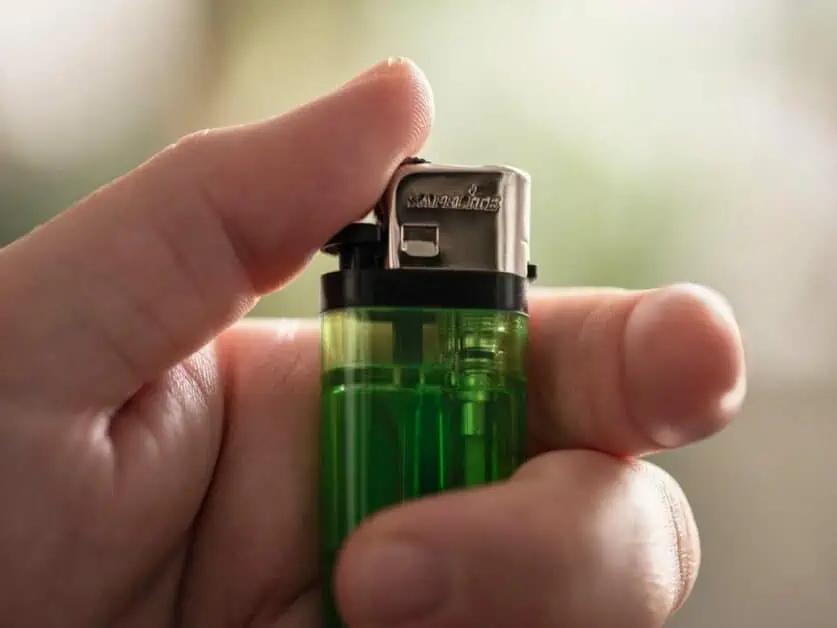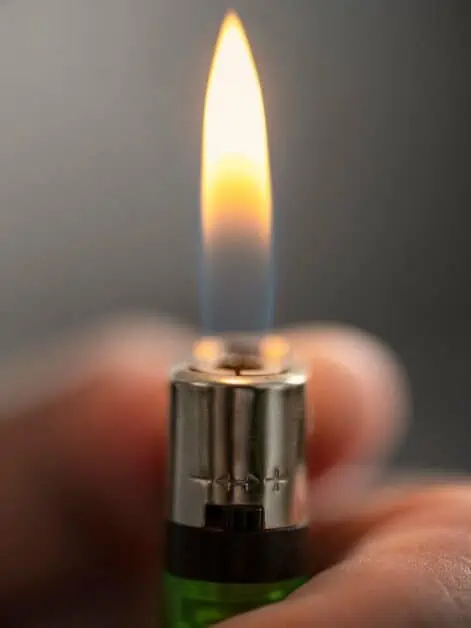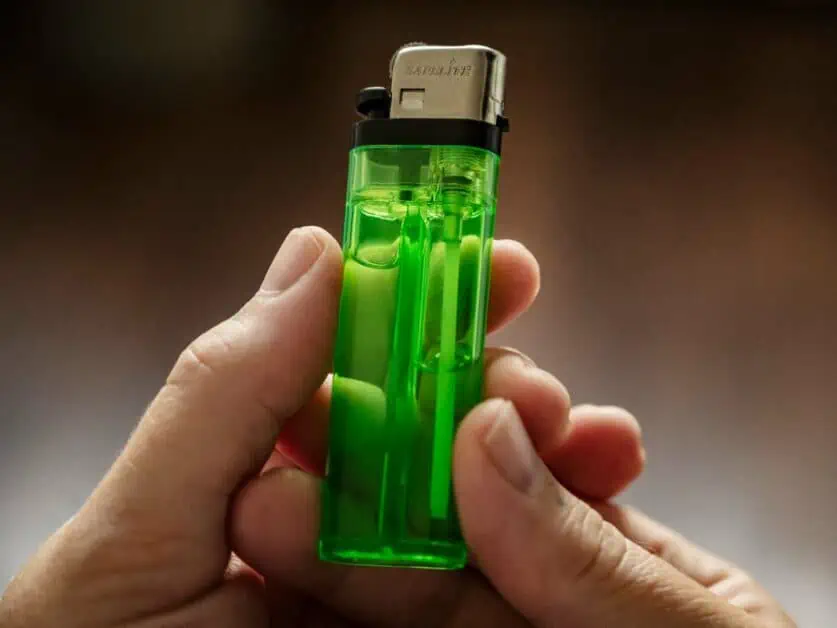Packing to go away on holiday can be complicated by trying to work out which items are allowed in your hand luggage and which ones have to go in the hold. Lighters are one of those items that it’s easy to get confused about. While there is some variance between different countries, usually you are not allowed to pack a lighter in your suitcase if it is going in the hold. You can sometimes take a lighter in your hand luggage, but often it isn’t permitted in your bag, and you have to carry it on your person. Given how cheap lighters are, the best option would be not to bring a lighter on a plane and instead to buy one when you reach your destination.

Table of Contents
ToggleWhy Wouldn’t You Be Allowed to Take a Lighter in Carry-On Luggage?
The obvious reason why there are restrictions on taking lighters on a plane is that they can cause fires. Most cigarette lighters, by design, are filled with highly volatile fuel with low combustion thresholds. Their whole purpose is to easily create a flame. No one wants to be on a plane that catches fire mid-flight! To reduce the risk of fires being started on planes, there are restrictions on the types and number of lighters that passengers can bring onboard.
Suitcases are tossed around during transport, and turbulence can cause further movement. A lighter packed in a bag in the hold could spill fluid and be cracked or broken. Most countries ban lighters from being transported in the hold, although it is sometimes allowed if the lighter is empty. The main reason for this is that some airplanes don’t have fire suppression systems in the hold. Older aircraft often have fire containment systems that require the plane to be landed if a fire is detected.
A further concern is that the hold is not under constant supervision. This means that the detection of any fire is reliant on automated systems. While the fire detection systems installed on planes are well-designed and regularly inspected, they can fail.
It is, therefore, logical to forbid anything that can potentially start a fire from being in suitcases in the hold. While the cabins of planes are usually fitted with full fire detection and suppression systems, it is still undesirable to have anything flammable in hand luggage. A lighter packed in a bag stowed in an overhead locker can be moved around by turbulence and could possibly start a fire unobserved. Therefore, most countries require a lighter to be carried on your person, not in a bag.
You may think this is overkill if you’re just wanting to take a lighter with you for a travel candle, or cigarettes for example. However, sadly, there is also the concern that a lighter could be used by terrorists or individuals wishing to harm others. Limiting the amount of lighters a passenger is permitted helps to reduce this risk.
So, Can I Bring My Lighter on a Plane as Carry-On Luggage?
It is usually illegal to pack lighters in your suitcase, but you may be permitted to bring a lighter into the cabin. There are typically additional restrictions that vary between different countries.
America – What Does the TSA Say About Lighters?
The Transportation Security Administration (TSA) is in charge of deciding which items are allowed on American planes. They allow disposable and Zippo lighters without fuel in checked bags. If your lighter has fuel, then there is a Department of Transportation exemption, which lets you have two lighters if they are in a DOT-approved case.
Only one disposable lighter can go in your carry-on bag. If you have a lithium battery-powered lighter that also has to go in your hand luggage. You cannot take lighter fuel or a torch lighter on a plane in America.
The UK – What Are the UK Government’s Regulations Concerning Lighters?
If you are traveling by plane in the UK, you cannot put a lighter in your hold or hand luggage. You can bring one lighter on a plane, but it has to be in a plastic bag, and you have to keep it on you in a pocket. The plastic bag must be transparent and resealable, hold no more than a liter, and measure less than twenty centimeters by twenty centimeters. You cannot take both matches and a lighter.
Europe – What Are the EU’s Guidelines Regarding Lighters?
It isn’t easy to work out what the EU’s rules about bringing a lighter on a plane are. The list of prohibited items has a category for ‘explosives and incendiary substances and devices capable, or appearing capable, of being used to cause serious injury or to pose a threat to the safety of aircraft’. The general definition of incendiary is something that is designed to create a fire. A lighter is, therefore, an incendiary device and presumably not allowed on board. However, the regulations for individual countries and airlines in Europe often state that disposable lighters can be taken on a plane.

Australia – Does the ABF Have Laws About Lighters?
Similar to other countries, the Australian Border Force (ABF) allows one lighter per passenger. There are only two types of lighter allowed on a plane. You can have a lighter containing liquefied gas, such as a BIC lighter with butane gas. Also allowed are lighters that use absorbed liquid fuel, for example, a Zippo lighter. Other types of lighters, like blue flame and torch lighters, are not allowed at all. You have to carry the cigarette lighter on you in a pocket; you must not pack it in your suitcase or your cabin bag.
- https://www.homeaffairs.gov.au/travelsecure-subsite/Pages/Items-you-cannot-take-on-plane.aspx
- https://dangerousgoodsapp.casa.gov.au/
New Zealand – What Are the CAA of New Zealand’s Rules About Lighters?
The Civil Aviation Authority of New Zealand (CAA) permits passengers to bring one lighter per person on a plane. They are very specific about the type of lighters that are allowed. According to their website:
- A gas lighter is allowed if it has two independent actions to activate ignition. Bic type lighters are compliant as they require the red button to be pushed down and the rotation of the spark wheel to generate a flame; or
- A lithium powered lighter, such as laser-plasma, tesla coils, flux and arc lighters, is allowed if it has a means to prevent accidental activation e.g. safety cap.
Survival firelighters are allowed, but cigar lighters, blue flame lighters, and large lighters, including those designed to light BBQs, and lighter fluid, are all banned. You must have your lighter in a pocket on your person and not packed in your carry-on or check-in bags. You cannot have both matches and a lighter, and you must not use your lighter while on the plane.
Canada – What Does the CBSA Say About Lighters?
The regulations of the Canada Border Services Agency (CBSA) allow passengers to have ‘disposable lighters (e.g. non-refillable Bic type) and non-torch lighters (e.g. Zippo type)’ in carry-on baggage. The decision as to whether you can bring a lighter on a plane in your checked baggage is up to the air carrier. You are not allowed lighter fuel, lighters with unabsorbed liquid fuel, torch lighters, gun lighters, or lighters shaped like grenades in either your carry-on or checked baggage.
- https://www.catsa-acsta.gc.ca/en/what-can-bring/item/lighter-fuel-and-refills
- https://www.catsa-acsta.gc.ca/en/what-can-bring/item/disposable-lighter-eg-non-refillable-bic-type
- https://www.catsa-acsta.gc.ca/en/what-can-bring/item/permitted-lighters
- https://www.catsa-acsta.gc.ca/en/what-can-bring/item/non-permitted-lighters
The Rest of the World
Air travel in regions such as Asia, South America, and Africa is not regulated by a single authority, but each country sets its own laws. The easiest thing to do is to ask the airline you are traveling with for guidance. As we can see above, there are usually restrictions on bringing a cigarette lighter onboard a plane. It is doubtful that any country or airline would allow you to pack a lighter in a suitcase going in the hold. Some will let you have a lighter in your carry-on bag, some will let you have a lighter on your person, and some completely ban lighters from the cabin.
- https://www.singaporeair.com/en_UK/us/travel-info/baggage/baggage-restrictions/
- https://www.ethiopianairlines.com/aa/information/baggage-information/restricted-items
- https://www.latamairlines.com/gb/en/help-center/faq/baggage/restricted-articles/restricted%20items
- https://www.china-airlines.com/tw/en/fly/prepare-for-the-fly/baggage/carry-on-baggage
What’s the Best Advice for Travelling on a Plane with a Lighter?
As we can see, lighters are subject to restrictions as they have the potential to cause a fire. The best advice is not to bring a lighter on a plane. They are very cheap to buy and readily available. It is extremely unlikely that you will be unable to pick up a cigarette lighter when you land at your destination. You cannot use a lighter on a plane, so you do not need to bring one onboard with you.
Like an electric toothbrush, there may be circumstances where you have to bring a lighter with you on an airplane. You may have a special lighter with a sentimental attachment, or you may have brought one as a souvenir or a present. You should check the regulations both of the countries you are landing and departing from and of the airline you are using.
The security officers who check your bags at the airport are the ones who make the final decision as to whether you can take your lighter on the plane. Regardless of the regulations, if they consider your lighter a threat, they have the right to confiscate it. There are a few things you can do to reduce the risk of this happening.
- Don’t pack your lighter in your suitcase. You should not put a lighter in your checked luggage going in the hold. If, for some reason, you need to pack lighters in your suitcase, you should contact your airline. You may be able to pack your lighters if they are in a special airtight, flame-retardant case. The TSA in America allows cases that are Department of Transport (DOT) approved. You usually have to fill in some kind of paperwork before you fly.
- Empty your lighter. The fluid in lighters ignites very quickly and is the chief area of concern for restricting the air transportation of cigarette lighters. If you empty your lighter of all of its fluid, then it will be viewed as less of a risk.
- Place it in a clear plastic bag. You should put your lighter in a clear plastic bag on its own, not in the same bag as your liquids. When you get to the security check, you need to put it in the tray so it can be clearly seen. This will make the security staff’s jobs easier and demonstrate that you understand and are complying with the guidelines governing traveling with a lighter.

What Happens If Your Lighter Is Flagged by Airport Security?
When you go through the security check at an airport, you may have forgotten you had packed a lighter, or a security officer may have concerns about it. If the lighter is in your checked luggage, your name will be called over the airport PA system. You will be directed to where your suitcase is being held, and you will be asked to open it for inspection. A security officer will examine the contents of your luggage, and they can remove any items they deem a risk.
If your lighter is flagged in your hand luggage, the tray containing it will be taken to a holding area. Once you have retrieved the rest of your belongings, you will need to make your way to the holding area. It is usually close to the scanning machines and easy to see. If the lighter is in your cabin bag, you will be asked to empty the contents into a tray so they can be checked. The security officer will explain to you why your lighter has been flagged, and he can decide to confiscate it.
It is essential to remember that the security staff are doing their job. They are employed to spot items that could endanger passengers, including you. Therefore, being rude and offensive to them is unnecessary and counterproductive. If you are polite and reasonable, you may be able to explain why your lighter is not a risk. However, if the security officer decides to take away your lighter, their decision is final.
Any items removed at security are usually passed on to the airline. Airlines normally keep these items for a few days before disposing of them. If you lose your lighter at the security check and want it back, you need to contact the airline as soon as possible to make arrangements.
What Are the Different Types of Lighters
The regulations controlling bringing a lighter on a plane mention various different types. Some kinds of lighters are allowed, while others are strictly forbidden.
- Plastic, disposable lighters. These are the common lighters that are widely available. They can’t be refilled, so once they are empty, they are thrown away. They usually have a plastic body with a wheel at the top made of serrated steel with a flint placed under it. If you push down hard enough on the wheel to move it quickly, it will rub against the steel and produce a spark. Most of these lighters have a lever to control the flow of fluid that has to be held down, or the flame will go out. These lighters contain volatile liquids that easily turn into flammable gas, such as butane or propane. The most well-known brand of spinwheel disposable lighters is BIC. This type of lighter is usually most likely to be allowed on a plane, typically carried on your person.
- Refillable, absorbed liquid fuel lighters. This type of lighter has a wick that is soaked in fluid. They often have a spinwheel to create a spark that lights the fluid on the wick. They have a lid that will put out the flame when closed. Because this type of lighter is refillable, they are often decorative or personalized. Zippo is the biggest brand of this type of cigarette lighter. If lighters are allowed on a plane, this type of lighter is usually acceptable.
- Electric, flameless lighters. This type of lighter does not need fuel. One kind of electric lighter works by heating up a coil, similar to cigarette lighters in a car. The more modern versions of electric lighters are also called arc lighters or plasma arc lighters. They create an arc of electricity that will ignite anything it touches. This type of lighter is usually allowed on planes, but you will have to check the regulations about batteries depending on how it is powered.
- Flint and steel, ferro-rod strikers, or survival firelighters. These lighters work by hitting the flint against the steel to create a spark. This type of lighter is not subject to restrictions when traveling on an aeroplane as they do not have any flammable fuel and they cannot accidentally create a flame.
- Torch, blue flame, cigar lighters. This type of lighter has a pressurized chamber that creates a jet of flame. The flame produced is steady and intensely hot. This makes them popular with cigar smokers. However, it also means they are rarely allowed on planes. To bring this kind of lighter on a plane, you usually need an approved case and a permit filled in before you fly.
- Large BBQ lighters. These lighters have a long neck with a trigger on the body. They are designed to light from a distance, making them ideal for BBQs. They typically contain butane and are made from plastic. This type of lighter is unlikely to be allowed on a plane.
Conclusion
As we have seen, figuring out whether you can take a lighter on a plane is complex. The best course of action would be to leave your lighter at home and buy a cheap disposable when you land. If you do need to take a lighter on a plane, check the regulations of the countries and the airline you are flying with. The most common rules will allow one lighter per person to be carried on your person in a pocket. You should place it in a clear plastic bag by itself and put it in a tray when you are going through security at an airport. If it is possible to empty the lighter fluid, then this would be a sensible precaution and reduce the chance of a security officer deciding to confiscate your lighter.
See other articles in this series:
- Can You Bring Nail Clippers on a Plane?
- Can You Bring Tweezers on a Plane?
- Can You Bring Hiking Sticks on a Plane?
- Can You Bring Shampoo on a Plane?
- Can You Bring Razors on a Plane?
- Can You Bring Curling Irons on a Plane?
- Can You Bring Deodorants on a Plane?
- Can You Bring Candles on a Plane?
- Can You Bring Scissors on a Plane?
